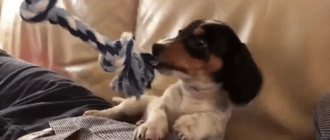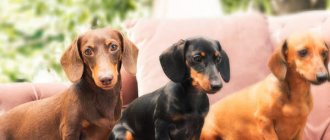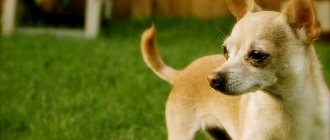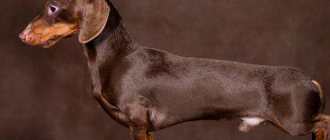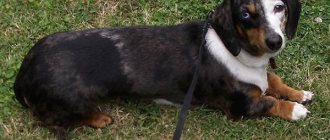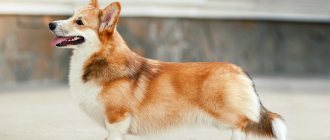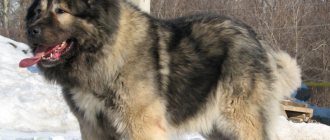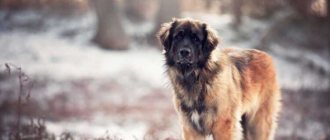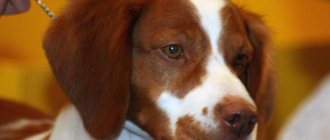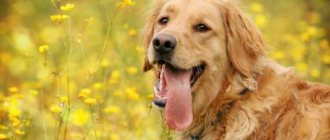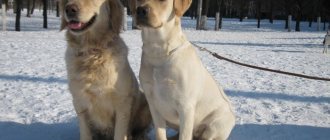Miniature dogs are very popular because they are easy to keep, easy to care for, and easily adapt to life in an apartment or country house. Very often, dog breeders choose dachshunds as companions. It should be remembered that this breed has several species that are very similar to each other and have a common history of origin. Knowing the difference between a regular dachshund and a mini dachshund, it is easier to make a choice in accordance with your preferences and the conditions that can realistically be created for your pet.
Separation by color
Dachshunds are divided not only by size and type of coat, but also by color.
The classic color of the dachshund, known throughout the world, is black and red. It comes in solid, marble, tan and brindle. The wire-haired species has a color called “boar” or simply gray. Single-colored red dogs are compared to deer for their nobility of color. In species with a solid color, black tips on the coat are allowed.
Marble color is distinguished by a blurring of spots on the main color, beige and gray. This color is characterized by black or brown claws and nose.
The brindle color is considered very rare. The peculiarity is the striped color, usually on a red or yellow background.
The isabella color is considered prohibited. Described as a bleached brown color. Dogs of this color suffer from skin diseases, and their immunity is greatly reduced.
Basic colors
Main colors of rabbit dachshunds:
- Black and tan.
- Ginger.
- Brown and tan.
- Brindle.
- Marble: black marble or brown marble.
For the wire-haired variety of the dwarf dachshund, boar coloring is also acceptable, which is considered a disadvantage for dogs with a different type of coat.
Interesting Facts
Many interesting facts are known about mini-rabbit dachshunds. For example:
- The rabbit dachshund was the favorite breed of Emperor William II of Germany, which is why such dogs suffered persecution during World War II. They were even considered a symbol of the enemy.
- Sometimes the breed is called not a rabbit, but a hare.
- No breeder can guarantee that as a rabbit dachshund matures it will not turn into a miniature one.
The rabbit dachshund is an ideal and cheerful companion. The miniature dog will become a true friend not only to the owner, but also to his entire family.
Basic rules of care
A smooth-haired rabbit dachshund only needs to be brushed from time to time..
In addition to periodic combing, a long-haired dachshund may also require haircuts once every six months, especially if the pet is a show pet.
And for a wire-haired dog, in addition to combing with a brush, trimming will be required, which should not be replaced with a haircut.
It is necessary to inspect your pet's ears and mouth every day, but cleaning them daily is not recommended . It’s better not to poke into your dog’s ears unless necessary, since even a cotton swab can easily injure the ear canal.
The eyes are cleaned with a damp cotton swab as they become dirty.
If necessary, claws need to be trimmed with special nail clippers, but it is better to give preference to guillotine-type nail clippers .
Make sure your dachshund rabbit always has toys or chew treats to clean his teeth with.
Hunting
Contrary to popular belief, dwarf Dachshunds are quite efficient, moreover, they are more playful than their standard counterparts. In defense of large Dachshunds, we note that they work successfully as hounds. Small dogs are used for burrow hunting in difficult terrain where there is a risk of the dog getting stuck in a passage . The dachshund does not kill the animal when a threat arises, but drives it to the surface, to the hunter.
The humanistic mood of society has led to the condemnation of hunting for fun and more and more Dachshunds are becoming sofa favorites. By the way, in addition to working skills, four-legged animals can boast of a sharp mind and the ability to adapt to the owner’s lifestyle.
How to feed
Rabbit dachshunds love to eat, which sometimes has a negative impact on their appearance and health, as they are prone to obesity.
In order not to overfeed the pet, the owner should not treat him with food from his table, no matter how touchingly the dog looks at him.
These dogs can be fed either a natural diet based on meat with the addition of cereals, vegetables, herbs and dairy products, or ready-made food.
Purchased food must be appropriate for the size, age and health of the pet..
It is very important that the food is of good quality and fresh. It is unacceptable to feed a rabbit dachshund the remains of food it has not eaten before; it is imperative to prepare a new portion of food for it.
Similarities between mini and standard dachshunds
When comparing two types of dachshunds, they have much more similarities than differences. It’s not for nothing that the dwarf one is called a smaller copy of the standard one. Both types are combined:
- exterior requirements;
- coat types and colors;
- character;
- hunting qualities;
- dietary features;
- diseases and hereditary pathologies;
- intelligence and intelligence;
- easy learning.
Description of the pet's character
The rabbit dachshund has a balanced, but at the same time energetic temperament . Friendly towards people, not aggressive, but at the same time, not fearful.
When hunting, she shows herself simply superbly, as she is courageous, purposeful and agile.
At home she is friendly, affectionate and gets along well with children. In addition, the rabbit dachshund is hardy enough to go on a long trip or hike with its owners.
She is mobile, active and just loves to run and play outdoors..
The rabbit dachshund can be a wonderful playmate for children, but adults need to ensure that the child does not tease the dog or play games with it that provoke aggression.
How is a dwarf dachshund different from a regular dachshund?
Depending on the size, dachshunds are divided into three types:
- standard;
- dwarf;
- rabbit
The main difference between the dwarf dachshund and the standard dachshund is its reduced size. Otherwise, the appearance fully corresponds to generally accepted characteristics.
Dimensions
The appearance of a standard taxi is not much different from a miniature one. Dogs have an elongated body with short, strong, slightly curved legs. The muscles on them are embossed and clearly defined. The skin of dachshunds is smooth, without folds. The shape of the head is elongated, slightly tapering towards the nose. The lips cover the lower jaw, forming small folds at the corners of the mouth. The teeth are straight and have a scissor bite. The eyes are oval, dark brown, blue or different colors. The ears are long, with rounded ends, hanging down and lying close to the cheekbones. The tail is thick, tapering towards the end.
Standard dachshunds are taller than mini dachshunds, the difference is about 10 cm. In the former, the height at the withers in adulthood is up to 27 cm, weight - up to 12 kg, in dwarf ones - height does not exceed 18 cm, weight no more than 5 kg.
Coat color
The coat of miniature dachshunds is not much different from the largest representatives of the breed. Three types of mini-dachshunds are recognized as standard:
- smooth-haired - they are convenient to keep in the house;
- long-haired - used only as decorative, the coat requires care;
- Wire-haired dogs are good hunters and easy to care for.
Among the colors of dachshunds there are those recognized by the standard:
- Monochrome - distinguished by the presence of only one color (from light beige to chocolate).
- Two-color - lighter tan marks on a brown or black field.
- Brindle – alternating light and dark stripes of red or sand color.
- Marble - the base background is black, on it there are asymmetrical spots of gray or cream color of different shapes and sizes.
The colors of mini taxis include piebold, double merle, isabella, sable and others.
Nutrition
All species are prone to obesity, so their diet is monitored very strictly. You can use natural or industrial feed. The best option is a mixed diet - ready-made granules are given at one of the feedings, and dishes made from natural products are given at the rest. To prepare them, lean meat, sea fish, vegetables, fruits, berries, dairy products, cereals and eggs are used.
Smoked meats, sweets, baked goods, salty and spicy foods, milk and legumes are excluded from the diet of standard and mini dogs.
The frequency of feedings for dogs of two types is no different:
- up to six months, puppies are fed 5-6 times a day;
- from 6 months to a year - three times;
- after 12 months - twice.
Differences in nutrition can be identified by comparing the amount of food provided to a regular and dwarf dachshund. A single serving is calculated according to the weight of the dog, and it is less for the mini type.
Character and behavior
As children, mini dachshunds are energetic and curious. Later, as they grow older, they become serious, leisurely and focused. The reduced size of the dogs had no effect on their character. They are just as independent and smart, friendly to those around them, and attentive and cautious towards strangers.
Since they were used as burrowing dogs, life forced them to be on guard and, if necessary, make independent decisions.
Dachshunds of any size and type are touchy, but dwarf dachshunds feel unfair treatment and deception especially keenly, and on occasion they can take revenge - making a puddle, ruining shoes and breaking dishes. Small representatives of the breed are angrier, more aggressive and more cunning than usual. You can correct the situation with the help of a reverent attitude towards them, attention, timely apologies after an insult and treats.
Health and illness, life expectancy
The lifespan of a standard dachshund is about 13 years. Dwarfs live 2-4 years longer.
The species is prone to diseases of the spine due to the structural features of the body, but in miniatures the load on it is less. All individuals develop retinal atrophy with age, the most common outcome being complete blindness. Hereditary diseases of the breed include myoclonic epilepsy. Mini Dachshunds are prone to obesity, diabetes, problems with joints and teeth, and skin diseases.
Necessary physical activity and exercise
The miniature dachshund is not much different from its relatives in its need for physical activity. She needs daily walks (at least twice a day) for 40-60 minutes. Mini dachshunds do not cause problems during joint walks with the owner outside the city, in the forest and in the country.
In public places, it is better not to let your baby off the leash. To prevent him from slipping out of the collar, use a harness.
You should be careful when going down the stairs; at this moment it is better to hold it in your arms. Due to their body structure and high risk of injury, pets should not be allowed to jump from heights or overcome obstacles.
Education and training
There are no particular differences in raising and training mini dachshunds. They need to start training as early as possible so that even in infancy they understand what behavior is acceptable and what is strictly prohibited.
You cannot raise your voice or physically punish a dachshund. In response, he is capable of harboring a grudge and will resist any order in every possible way. The foundation of successful parenting is kindness, persistence and confidence. Motivate your pet with treats and praise. Dogs are easy to train, easily learn and follow basic commands.
Dog mating
Unlike large dogs, mini dachshunds are allowed to be mated for the first time only after they reach two years of age. Before this, their body and psyche are not yet sufficiently formed. Before mating, it is necessary to examine the mini pet in a veterinary clinic, do tests, deworm it, and treat it for external parasites. Mating of animals is carried out on the territory of the dog under the supervision of a dog handler or an experienced breeder.
Pregnancy in mini dachshunds lasts from 60 to 70 days. Due to the small size of the dog, childbirth often occurs with complications and requires the help of a specialist. There are from 2 to 4 puppies in a dwarf dachshund litter.
Walking, physical activity and rules of safe behavior on the street
The rabbit dachshund has a tendency to obesity, so it needs long and active walks with mandatory physical activity. It is best to organize your walks as follows:
- In parks, with mandatory games.
- The duration of the walk should be at least 30 minutes and at least 2 times a day.
- You should spend time actively not only outdoors, but also at home.
Important! In cold weather, it is better to wear warm overalls on your dog.
Nutritional Features
For rabbit dachshunds, the issue of proper nutrition is acute, which should be addressed from an early age. Puppies greedily swallow food whole; this problem can be solved by throwing a ball selected to the size (for example, from a ping pong) into a bowl or chopping the food.
From 4 meals a day (puppies up to 3 months old) you need to transfer your dachshund to 3 meals a day, and by one year to 2 meals a day without snacks.
Since the breed is prone to obesity, constant weight control and a minimum amount of sweets in the diet are required. You cannot feed an adult dog puppy food, which is rich in fat.
Check out the advantages and disadvantages of dog foods such as Barking Heads, Flatazor, 1st CHOICE, Almo Nature, Probalance, Wolfsblut, Pronature, Grandorf, Pedigree.
It is better to have a mixed diet, including natural ingredients. It is better to use food for dogs with increased activity. And in order to protect your dog from allergic reactions and digestive disorders, the food must be of high quality.
Natural products include meat (beef, chicken), vegetables, kefir, cottage cheese, porridge (buckwheat, rice). Since the rabbit dachshund is a highly active dog breed, it requires a large energy reserve.
Your diet should include carbohydrates and fiber-rich foods. For better development, it is advisable to feed your pet with vitamin and mineral complexes several times a year.
You should definitely exclude fatty, smoked, spicy and salty foods, as well as milk, from your diet. Food should be fresh and at room temperature. Leftover food should not be left in the bowl. Remember that your dog constantly needs fresh drinking water.
Important! After eating, active games and exercise are contraindicated, therefore, you should not feed your rabbit dachshund before a walk!
Possible deviations
- Irregular chest – sunken or normal shape;
- Lack of teeth;
- Tail defects - crease, bend, tail ring;
- Fear, aggression, lethargy, apathy;
- The puppy may not gain weight or, on the contrary, be too well-fed;
- Stiffness of movement, lameness;
- Sagging back;
- Narrow or too wide lower back;
- Distorted jaw, malocclusion;
- Crooked paws;
- Not standard color;
- Cryptorchid – non-descent of the testicles into the scrotum;
What actions with mini-dachshunds are unacceptable?
The main part of the dangers for a pet is associated with its small size and physique. Until they are six months old, you should not leave your dachshund unattended on the sofa. There is a high probability of damage to the spine and limbs after a jump from a height.
When going down the stairs on your own, the load on the front legs and spine increases. The baby is picked up to eliminate the risk of curvature of the paws and displacement of the vertebrae.
Accustoming to a new type of food and switching from one to another must be done gradually so as not to cause disturbances in the gastrointestinal tract.
Mini-sized dachshunds are vaccinated in accordance with the vaccination calendar and only after deworming.
You should not play tug-of-war with your pet until the teeth and bite are fully formed to avoid deformation and misalignment of the jaws.
During training, mini taxis should not be indulged; they should know and feel who is boss.
Who is better to choose?
Which dachshund to choose is up to each dog owner to decide for himself. It all depends on preferences, goals and capabilities. Both species are not exotic, but mini dachshunds are somewhat less common than standard ones.
You should not purchase puppies from dubious breeders or through advertisements. The most reliable option is a nursery, where they can provide all the documents, pedigree, and show the baby’s parents. Preference is given to purebred puppies from well-known producers. Pay attention to the appearance of the baby dachshund. He must be active, mobile, curious and easy to contact. The eyes and ears of a healthy puppy are clean, the coat is bright and shiny, without bald spots.
Separation by coat
The indefatigable imagination of breeders and breeders divided the breed into varieties based on their coat. Today, dogs are distinguished with three different coats: smooth-haired, wire-haired and long-haired.
The most ancient are smooth-haired representatives, with fur that fits tightly to the body. The short fur is so densely packed on the animal’s body that it shimmers in different colors in the sun, shimmering like gloss. Thick and short hair perfectly protects the dog’s skin from dirt and extreme wetness.
Wirehairs have a very hard coat. And under the top coat there is a dense undercoat. A touching feature of wire-haired dogs is a small beard and mustache and eyebrows, making pets, even puppies, look like aged sages.
The long-haired dachshund is the shaggiest of all species. Soft wool, as if slightly curled in curlers, very pleasant to the touch, shiny and silky. The standard does not allow excessive curling, so representatives of this species often have straight but long hair. Certain parts of the body, such as ears, tail, hind legs, are covered with hair more densely.
